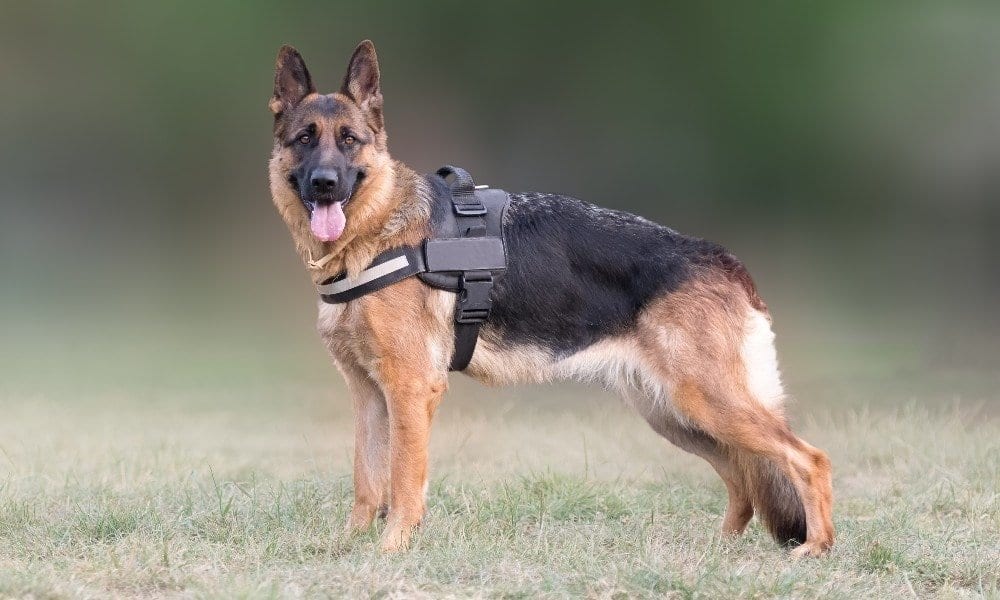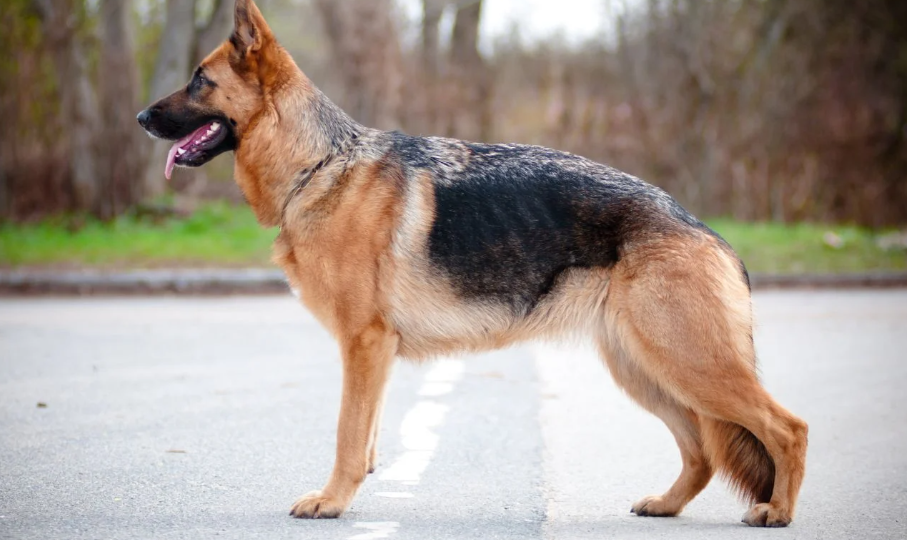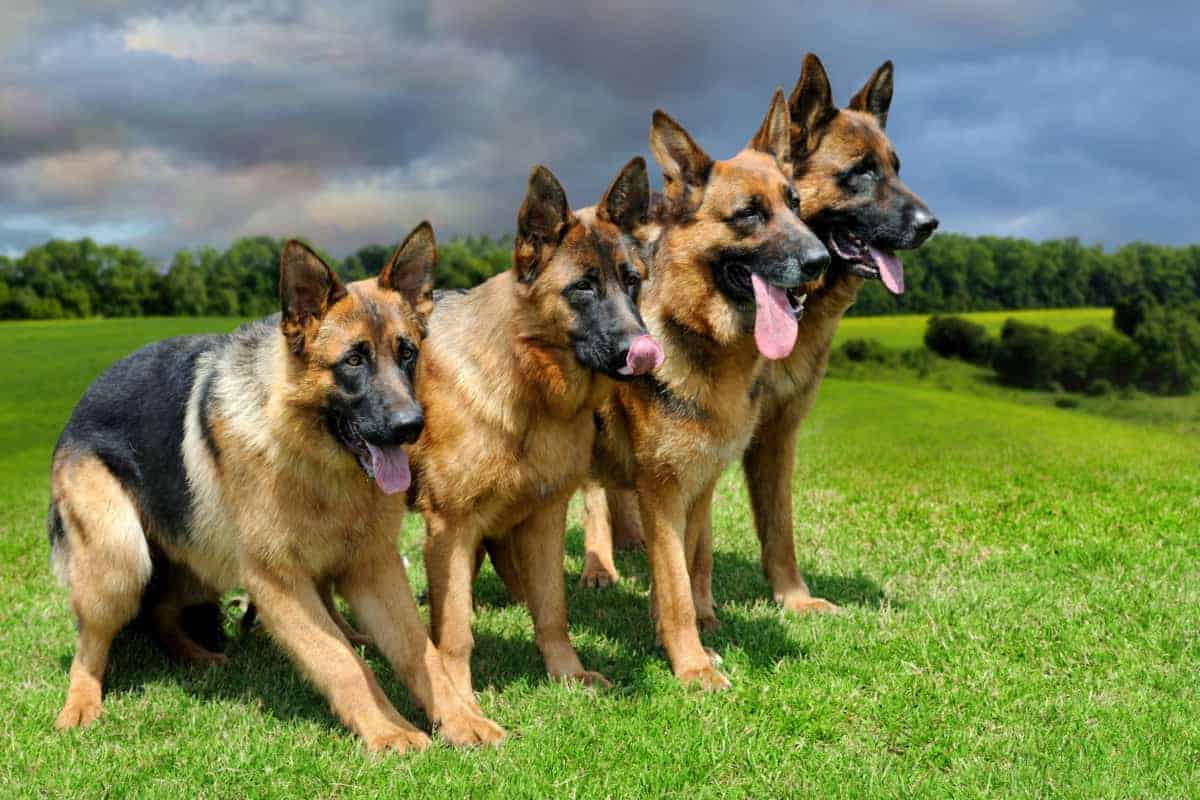What Kind Of Disease Does A German Shepherd Have
When it comes to ailments, German shepherds typically show signs of hip and hindquarter weakness. Below are four common disorders of the hip and joint commonly seen in this breed: As a German shepherd owner, you have likely heard of the fatal, chronic, and progressive disease called degenerative myelopathy that is most prevalent in this breed.
How Much Exercise Do They Need
The German Shepherd is a working dog and requires a considerable amount of physical and mental exercise to stimulate them and keep them out of mischief. This is not a breed thats happy to be a couch potato. The best toys for German Shepherds are the ones that require physical activity and mental stimulation. We review the best dog toys and brain games to help you give your pup what they need.
Its crucial to provide a long daily walk or, better yet, a run. Obedience training and games can also help stimulate this dogs active brain. These dogs love pack games like fetch or frisbee, which also serve well to tire them out.
If you were wondering how fast can a German Shepherd run, the answer is up to 30 mph.
Maybe you are also asking, do German Shepherds like water? Or can German Shepherds swim? While they are certainly capable of learning to swim, they dont always take to water naturally.
If youre curious about how much exercise your dog gets daily, consider getting a dog activity tracker.
What Is The Best Dog Food For A German Shepherd
German Shepherds require a low-protein diet of around 18% protein and 1,740 to 2,100 calories per day. Giving your pup high-quality dog food should eliminate the need for supplemental vitamins and nutrients. Some dogs require specific dietary requirements, so be sure to check with your vet about the right food for your dog. If you want to simplify feeding in your home, our experts review fresh dog food, raw food, and food delivery options.
Recommended Reading: Can A Chihuahua And A German Shepherd Mate
The 4 Stages Of A Dogs Growth And Development
I think we can all agree that its difficult to figure out the best way to take care of your dogs health. Not knowing about a German shepherd average weight and height only adds to the list of problems.
As German Shepherds grow through the stages of their life, they also develop more health risks. But are the stages of a dogs life?
Variations Of German Shepherds

It is worth noting that these charts do not apply to the different variations of Shepherds, except possibly White German Shepherds .
East-European Shepherds, King Shepherds, and Shiloh Shepherds are bigger than standard German Shepherds. Miniature German Shepherds are much smaller and have completely different development requirements and problems.
You May Like: German Shepherd With Other Dogs
Why Do German Shepherds Grow Bigger Than Other Dogs
However, a German shepherds average weight and height can be affected by genes and their environment. Therefore, a pup may grow larger or smaller than the other. This article looks at the standard German shepherd weight and a height chart so owners may be able to understand their dogs better.
Age Weight Growth 4 month old German shepherd 19.0kg 55% of total growth 5 month old German shepherd 22.9kg 66.57% of total growth 6 month old German shepherd 26.1kg 75.52% of total growth 7 month old German shepherd 28.4kg 82.36% of total growth
Obviously, the size chart of German shepherd males will exceed the typical female German shepherd weight. The same goes for their height. Just like with their weight, German shepherds stop growing typically reach the end of their growing process as they reach their first year.
What Age Is A German Shepherd Fully Grown By
Your German Shepherd will have acquired much of their adult size and weight by the time they have hit their first year. However, they will continue to grow, usually reaching their full adult size somewhere between 18 months to 2 years of age.
The age of maturity, though, is somewhat dependent on the specific type of German Shepherd that you have. Eastern European varieties, for instance, are particularly late bloomers and are unlikely to reach their full size much before the age of three.
Larger dogs will also naturally take longer to achieve their full size. A female German Shepherd might be expected to get there at 24 months, whereas for a male, it could be closer to 30.
Also Check: How Much Does It Cost To Neuter A German Shepherd
Meet The World Famous German Shepherd Dog
The German Shepherd breed is actually a relatively recent purebred dog breed.
According to the German Shepherd Dog Club of America , in 1889, a German officer named Captain Max von Stephanitz saw a very unusual dog at a dog show.
The dog appeared to be half domestic canine and half-wild wolf. Intrigued and fascinated, von Stephanitz purchased the dog and launched a breeding program. His goal was to create the perfect herding and livestock guard dog.
Today, this original dog is the founding father of all modern German Shepherd dogs all over the world.
While Captain von Stephanitz bred only for function and temperament and not for appearance, his original studbook records at least three potential crosses between wild wolves and domestic dogs.
And of course, as Western Wildlife Outreach points out, wild wolves all have one singular feature a long bushy tail. So this is likely where the modern German Shepherd dog has gotten their long bushy tail from.
Why Get Pet Insurance For Your German Shepherd
As a pure breed dog, German Shepherds are at a higher risk for certain health and genetic conditions. Hip dysplasia and cataracts are some of the most common issues to plague this pup. German Shepherds are more susceptible than other breeds to a condition called gastric dilatation volvulus, more commonly called âbloat.â This is when the stomach twists and cuts off blood flow. If your German Shepherd is known to scarf down their food, consider getting a slow feeder bowl or keep an eye on them at mealtimes.
And like other large-breed pets, heart issues like murmurs, valve disease, and enlarged hearts are very common.
Fearless and adventure-seeking, German Shepherds can run themselves ragged, which leads to unexpected injuries like torn cranial cruciate ligaments.
Because of their large size and how quickly they grow, German Shepherds are also prone to osteochondritis dissecans of the knee, which is usually diagnosed in puppies between four to eight months of age and almost always requires surgery.
You May Like: Who Would Win German Shepherd Or Pitbull
How Big Can A German Shepherd Get
The German shepherd or the Alsatian dog is the second most popular breed of dog. This breed of dog is intelligent, loyal, and fun to have.
Captain Max von Stephanitz bred this medium-sized dog for herding purposes. Additionally, this multipurpose dog full of intelligence and keen senses of smell has found favor among police and armed forces over the years.
Also, when it comes to size, the GSD is a medium-sized breed. That said, by the end of this article, you will have understood how big a female or a male GSD could get either during puppyhood or adulthood.
So, if you have been wondering how big a German shepherd can get, you are in the right place.
Contents
What Should I Do If My German Shepherd Is Overweight
Consult with your veterinarian about the best diet to control your dogs weight. German shepherd dogs are prone to conditions such as arthritis, elbow dysplasia and hip dysplasia. These conditions can be worsened if the dog is allowed to become overweight.
Puppy Growth Chart A healthy large breed puppy will normally double her birth weight during the first week. This is followed by a consistent weight gain of 5-10%. And moderates to an ultimate weight of around 70 times the puppys birth weight.
You May Like: How Much Are Akc German Shepherd Puppies
How Big Is A Full Grown German Rottweiler
Male Rottweilers should fall between 24 to 27 inches tall, weighing in at 95 to 135 pounds. In comparison, female Rottweilers are slightly smaller at 22 to 25 inches tall and 80 to 100 pounds. These numbers are estimates, and some Rottweilers will be smaller or larger based on their genetics and environment.
What Should I Give My 5 Month Old German Shepherd

Ingredients such as bones, pieces of liver and raw eggs are beneficial to help your dog assimilate the nutrients that may be missing in his dry dog food. Avoid giving them too much of this type of food. At 5 months of age, your puppy will have become used to its new dry food, along with the food ingredients you have started to give it.
Read Also: Do German Shepherds Ears Naturally Stand Up
What Can I Do With My 15 Month Old Baby
You may also let the baby throw balls or bean bags small objects into the laundry basket, as this improves hand-eye coordination. Make her to stand away from the basket and practice this target throwing activity. Skills developed: gross motor skills, imaginary skills, balancing skills, and language skills. 2. Finger Paints
Five Main Types Of German Shepherds
There are five main types of German Shepherds that you will come across:
Read Also: When To Neuter A German Shepherd
How To Get Your German Shepherd To A Healthy Weight
Being overweight is very dangerous for this breed it increases their risk of heart disease and other diseases, and it places extra strain on their joints, particularly the hips this is important to note, because this breed is very prone to hip dysplasia. Dogs usually become overweight from a combination of overfeeding and under-exercising, just like humans.
- Help Your Dog Eat More Gradually: Instead of free-feeding your dog, divide their food into multiple small meals a day. You can use a slow feeder bowl or toy to help them eat more gradually. As your dog ages, its metabolism will slow down. So you may need to adjust its food as it grows from a puppy to an adult, and then from an adult to a senior. Make sure that you give minimal amounts of people food and keep treats to a reasonable level.
- Be Careful With Treats: When training or playing, you can reward your German Shepherd with small training treats or simply with toys.
- Make Sure Your Dog Exercises Regularly: Its also important to give your them regular exercisethey dont do well as couch dogs! These dogs should be getting at least an hour of exercise every day. So go for a walk, take a jog, or simply play fetch in the yard. It will be good for your health too.
Correct Proportions Of A German Shepherd
According to the German Shepherd Dog Club of America, both male and female German Shepherd dogs should have a 10:8.5 ratio of length to height.
Length is measured from the dogs breastbone to the rear edge of its pelvis, and height is measured along the withers.
When your German Shepherd is the ideal weight, you can feel their ribs, although they are not easily seen, and they are not covered in a layer of fat.
There should be a defined waistline when your dog is viewed from above and a noticeable tummy tuck when they are viewed from the side.
Recommended Reading: German Shepherd And Chihuahua
Skeletal Health And Supplementation
Musculoskeletal disorders are debilitating conditions that are often associated with genetic makeup, malnutrition, and stress-related events. Some breeds like the German shepherd, are predisposed to a variety of different skeletal disorders, including but not limited to: canine hip dysplasia, Cauda equina syndrome, and osteoarthritis. These conditions can be a result of poor breeding or induced by intense exercise and poor diet.
Canine hip dysplasia is an orthopedic condition resulting from abnormal development of the hip joint and surrounding tissue causing the instability and partial dislocation of the hip joint, resulting in pain, inflammation, lameness, and potentially osteoarthritis of the joint. German shepherds are genetically predisposed to CHD and the University of Veterinary Medicine in Germany found its prevalence estimated to be approximately 35% of veterinary cases associated with the disorder.
Osteoarthritis is one of the main contributors of musculoskeletal pain and disabilities that commonly affect German shepherds. Mechanical stress, oxidative damage and inflammatory mediators combine to induce the gradual degeneration of the articular cartilage in the joint, resulting in reduced muscle mass, pain, and locomotion.
Vitamins such as A and D also have crucial roles in bone development and maintenance by regulating bone and calcium metabolism. Adequate levels should be incorporated into a German shepherd diet to promote a healthy musculoskeletal system.
When Will A Gsd Puppy Tail Get Bushy
Earlier here we mentioned that German Shepherds as a general rule can take a longer period of time to mature. As this German Shepherd owner forum thread indicates, this can really confuse GSD owners.
The best way to know how long your German Shepherd will take to reach their full adult size and conformation is to learn as much as you can about the parent dogs.
As the official GSD breed standard explains, adult German Shepherds can range in size from 65 to 90 pounds and stand anywhere from 22 to 26 inches tall .
As well, depending on the breed line your GSD puppy comes from, it can take anywhere from 18 months to 36 months to fully mature.
This is important to know because the larger your puppys parents are, the longer your pup is likely to take to reach their full adult size, weight, coat, and tail.
As well, the breed line can influence the time to maturity, with the East German and Czech lines taking the longest in general to mature.
If your GSD puppy has reached a year and a half old and the tail still isnt bushy like you expected, it may be that your dog comes from a breed line or from parents that do not have the big bushy, fluffy tail trait.
Alternately, it could be that your puppy just comes from a breed line that takes longer to mature and you have a bit longer to wait before that fluffy, bushy tail fully grows in.
Don’t Miss: German Shepherd Pregnancy Length
What Does How Tall Does A German Shepherd Get Look Like
The German shepherd is a large dog with a strong skeleton and well-developed muscular physique. how tall does a german shepherd get have a wide powerful chest, a slightly lowered pelvis, and an easily recognizable stand. Limbs are long, smooth and strong, and the tail is straight and saber forms. Skin-tight leather of the how tall does a german shepherd get body, so that no folds are formed. The head of the shepherd wedge, the ears are large, erect, slightly pointed at the tips.
The coat of the how tall does a german shepherd get is short and dense, with a developed undercoat, which allows you to transfer even cold. The colors are very different: black and grey, but the most common are black .
Why Is My German Shepherd Gaining So Much Weight

What If My German Shepherd Is Growing Too Fast The most common cause of a puppy growing too fast is their diet. If you overfeed your puppy, your puppy will gain too much weight, but there is a bigger problem. Puppy food is so high in nutrition, that when you give a puppy too much, he will suffer from over-nutrition.
Don’t Miss: How Much Weight Can A German Shepherd Carry
Months And Onward: Adulthood In German Shepherds
Although some female German Shepherds can reach full adulthood by 16 months, most only reach it by 18 months to 2 years. Male German Shepherds only reach full adulthood around the ages of 2.5-3 years.
| Age | |
| 22 24 | 55 60 |
Here is a great video of just what you can expect from a German Shepherds growth in terms of size as well as personality from 7 weeks to 2 years old:
A German Shepherds Size Often Varies According To Type
There are five basic types of German Shepherds. Purposely-produced pet Shepherds, bred for less aggression, lower exercise requirements, and decreased work and prey drive, are similar in size to the show or working dogs from whence they originate. Many pet German Shepherds are from casual or backyard operations and can vary widely in size, most on the large end of the scale near 100 pounds.
American show lines are taller and correspondingly longer than their West German counterparts. West German show lines tend to have denser bone than the American dogs but weigh less. There are no AKC formal weight restrictions, so some American show dogs are over 100 pounds.
East German, West German, and Czech working lines of the German Shepherds tend to be smaller and lighter than show lines. Czech working dogs are generally the smallest of all, often only ranging from 20 to 25 inches tall at the shoulders.
Also Check: How Big Do German Shepherd Beagle Mixes Get